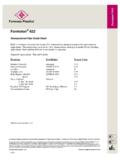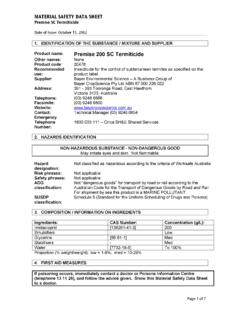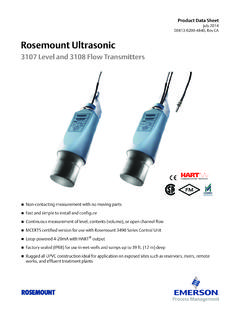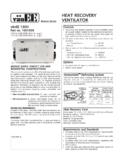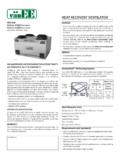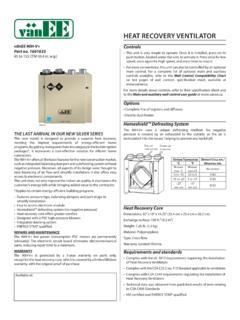Transcription of Ficam W Insecticide - Greenway pest control services
1 MATERIAL SAFETY data sheet Ficam W Insecticide Date of Issue: September 13th, 2006 1. IDENTIFICATION OF THE SUBSTANCE / MIXTURE AND SUPPLIER Product name: Ficam W Insecticide Other names: None Product code: 4209426 (150 g), 4208454 ( kg) Chemical group: Carbamate Recommended use: A general purpose residual Insecticide for use in and around buildings, as a seed treatment and on turf. Formulation: Wettable powder (WP) Supplier: Bayer Environmental Science A Business Group of Bayer CropScience Pty Ltd ABN 87 000 226 022 Address: 391 - 393 Tooronga Road, East Hawthorn Victoria 3123, Australia Telephone: (03) 9248 6888 Facsimile: (03) 9248 6800 Website: : Technical Manager (03) 9248 6888 Emergency Telephone Number: 1800 033 111 Orica SH&E Shared services 2.
2 HAZARDS IDENTIFICATION HAZARDOUS SUBSTANCE - DANGEROUS GOOD Toxic by inhalation and if swallowed. Harmful in contact with skin. Not flammable. Hazard designation: Hazardous (National Occupational Health and Safety Commission - NOHSC) Risk phrases: R23/25 Toxic by inhalation and if swallowed R21 Harmful in contact with skin Safety phrases: See sections 4, 5, 6, 7, 8, 9, 13 ADG classification: Dangerous Goods for transport by road and rail according to the Australian Code for the Transport of Dangerous Goods by Road and Rail CARBAMATE PESTICIDE, SOLID, TOXIC (bendiocarb) Class , Packing Group III UN2757 SUSDP classification: Schedule 6 3. COMPOSITION / INFORMATION ON INGREDIENTS Ingredients: CAS Number: Concentration (g/kg): Bendiocarb [22781-23-3] 800 Other ingredients (non hazardous) 200 Page 1 of 7 MATERIAL SAFETY data sheet Ficam W Insecticide Date of Issue: September 13th, 2006 4.
3 FIRST AID MEASURES If poisoning occurs, immediately contact a doctor or Poisons Information Centre (telephone 13 11 26), and follow the advice given. Show this Material Safety data sheet to a doctor. Inhalation: Remove person to fresh air. If signs of poisoning occur get medical attention immediately. Persons assisting the patient should protect themselves from contamination. If advised by doctor or Poisons Information Centre, atropine tablets may be administered. Artificial respiration may be required. Skin contact: If poisoned by skin absorption, remove any contaminated clothing, wash skin thoroughly with soap and water and continue flushing with water for at least 15 minutes. Seek medical attention if irritation develops or persists.
4 If signs of poisoning occur get medical attention immediately. Persons assisting the patient should protect themselves from contamination. If advised by doctor or Poisons Information Centre, atropine tablets may be administered. Eye contact: Rinse immediately with water for at least 15 minutes and seek medical advice. Ingestion: Induce vomiting if patient is fully conscious, time since ingestion is less than 30 minutes and medical aid is readily available (vomit should not get into respiratory tract). Wash out mouth with water. Keep patient at rest and seek urgent medical advice. Transport patient to doctor or hospital quickly. If advised by doctor or Poisons Information Centre, atropine tablets may be administered.
5 DO NOT attempt to give anything by mouth to a semi-conscious or unconscious person. First Aid Facilities: Obtain an emergency supply of atropine tablets mg. Symptoms: Bendiocarb belongs to the carbamate group of insecticides, which are acetylcholinesterase inhibitors. Inhibition of acetylcholinesterase results in accumulation of the neurotransmitter acetylcholine in the central and peripheral nervous system. Symptoms of poisoning include mild intoxication causes headache, blurred vision, weakness, sweating, mild chest pain, nausea and vomiting. Severe intoxication causes cyanosis, muscular twitching, spasms, miosis and respiratory paralysis. Onset of symptoms may be delayed. Cholinesterase inhibition sometimes persists for several weeks.
6 Medical attention: Basic aid, decontamination, symptomatic treatment and if necessary administration of antidote (atropine). Note for physicians Endotracheal intubation should be done and gastric lavage performed, followed by administration of charcoal. Treatment is with atropine sulphate. Additionally diazepam should be given in case of seizures/convulsions. Atropine should not be given to a cyanosed patient. Monitor respiratory, cardiac and central nervous system functions. Monitor red blood cell and plasma cholinesterase levels. Administer oxygen if necessary. Watch for pulmonary oedema and delayed neurological symptoms. Contraindications include oximes (pralidoxime, oblidoxime), succinyl chloride and aminophylline.
7 Page 2 of 7 MATERIAL SAFETY data sheet Ficam W Insecticide Date of Issue: September 13th, 2006 4. FIRST AID MEASURES - continued Medical attention continued: 2 regimens for initial atropine treatment are currently suggested, in both cases the cessation of the cholinergic symptoms salivation, bronchial secretion, sweating and bradycardia indicates sufficient atropinization. The skin should be dry, the lungs should be clear on auscultation and the heart rate should be in a range of 80 to 100/minute. Overdoses of atropine have to be strictly avoided, as these can promote heart rhythm disturbances. Regimen 1: (2-10 mg atropine , followed every 15 minutes by 2 mg atropine until cessation of the symptoms.)
8 Regimen 2: - 2 mg atropine , 5 minutes wait, if symptoms persist or reappear - 4 mg atropine , 5 minutes wait, if symptoms persist or reappear - 8 mg atropine , 5 minutes wait, if symptoms persist or reappear - 16 mg atropine , 5 minutes wait, if symptoms persist or reappear - 32 mg atropine No higher doses of atropine should be given nor are necessary. For children, the dosage has to be more careful due to a higher sensitivity of children to atropine. The initial dose should be mg/kg body weight, then careful repletion or increase depending on the reversal of symptoms as described above. It is mandatory to allow 5 minutes after each dose for atropine to become fully effective, the next higher dose must not be given earlier and only if the above symptoms are persisting.
9 Regimen 2 currently is advisable. If further atropine treatment is required (taking into account the relatively short effect of carbamates), it should be done by continuous application of 1 2 mg/hour. Atropine treatment can be stopped, when the plasma cholinesterase level has returned to above 30% of normal. 5. FIRE FIGHTING MEASURES Extinguishing media: Water fog or fine spray, carbon dioxide, dry chemical, foam. Hazards from combustion products: Fine dust may form explosive mixtures in air. The product is not flammable, but when heated above 125 C will evolve toxic fumes of methyl isocyanate. Water is the preferred extinguishing medium as it decomposes any methyl isocyanate. Precautions for fire fighters: Fire fighters should wear full protective gear, including self-contained breathing apparatus (AS/NZS 1715/1716).
10 Keep unnecessary people away and move all other personnel to windward side of fire. Bund area with sand or earth to prevent contamination of drains or waterways. Dispose of fire control water or other extinguishing agent and spillage safely later. Page 3 of 7 MATERIAL SAFETY data sheet Ficam W Insecticide Date of Issue: September 13th, 2006 6. ACCIDENTAL RELEASE MEASURES Dealing with spills and disposals may result in the potential for increased personal exposure. Protective clothing and equipment as described in the PERSONAL PROTECTION section should be worn. Avoid contact with spilled material or contaminated surfaces. Keep people and animals away. Prevent spill from entering drains, sewers or any body of water.
